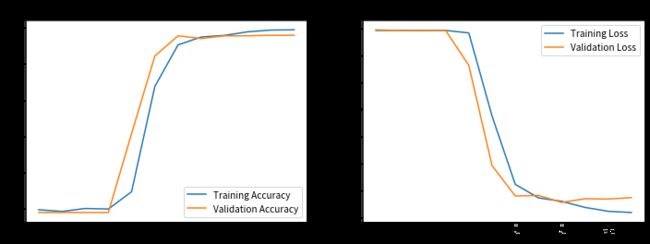深度学习第9周猫狗识别2
- 本文为365天深度学习训练营 中的学习记录博客
- 参考文章:365天深度学习训练营-第9周:猫狗识别-2(训练营内部成员可读)
- 原作者:K同学啊|接辅导、项目定制
第9周:猫狗识别-2
● 难度:夯实基础⭐⭐
● 语言:Python3、TensorFlow2
要求:
- 找到并处理第8周的程序问题(本文给出了答案)
第8周的问题处在训练集和测试集数据的历史损失和准确率,因为是每一个batch输出一次history而不是epoch输出一次,因此需要对一个epoch中的8个batch取平均值。
拔高(可选):
- 请尝试增加数据增强部分内容以提高准确率
- 可以使用哪些方式进行数据增强?(下一周给出了答案)
探索(难度有点大)
- 本文中的代码存在较大赘余,请对代码进行精简
一、前期准备
import tensorflow as tf
import matplotlib.pyplot as plt
gpus = tf.config.list_physical_devices("GPU")
if gpus:
tf.config.experimental.set_memory_growth(gpus[0], True) #设置GPU显存用量按需使用
tf.config.set_visible_devices([gpus[0]],"GPU")
# 打印显卡信息,确认GPU可用
print(gpus
[PhysicalDevice(name=‘/physical_device:GPU:0’, device_type=‘GPU’)]
2、导入数据
import PIL,pathlib
dir_path = r'/home/mw/input/88559128/dataset/dataset/365-7-data'
dir_path = pathlib.Path(dir_path)
image_cnt = len(list(dir_path.glob('*/*.jpg')))
image_cnt
3400
二、数据预处理
1. 加载数据
batch_size = 8
img_height = 224
img_width = 224
train_ds = tf.keras.preprocessing.image_dataset_from_directory(dir_path,
batch_size=batch_size,
image_size=(img_height,img_width),
seed=12,
shuffle=True,
validation_split=0.2,
subset="training")
val_ds = tf.keras.preprocessing.image_dataset_from_directory(dir_path,
batch_size=batch_size,
image_size=(img_height,img_width),
seed=12,
shuffle=True,
validation_split=0.2,
subset="validation")
class_names = train_ds.class_names
class_names
[‘cat’, ‘dog’]
2. 再次检查数据
for image_batch, labels_batch in train_ds:
print(image_batch.shape)
print(labels_batch.shape)
break
(8, 224, 224, 3)
(8,)
3. 配置数据集
from tensorflow.keras import models,layers
import numpy as np
AUTOTUNE = tf.data.experimental.AUTOTUNE
def preprocess_image(image,label):
return (image/255.0,label)
# 归一化处理
train_ds = train_ds.map(preprocess_image, num_parallel_calls=AUTOTUNE)
val_ds = val_ds.map(preprocess_image, num_parallel_calls=AUTOTUNE)
train_ds = train_ds.cache().shuffle(1000).prefetch(buffer_size=AUTOTUNE)
val_ds = val_ds.cache().prefetch(buffer_size=AUTOTUNE)
4、查看图片
from tensorflow.keras import models,layers
import numpy as np
AUTOTUNE = tf.data.experimental.AUTOTUNE
def preprocess_image(image,label):
return (image/255.0,label)
# 归一化处理
train_ds = train_ds.map(preprocess_image, num_parallel_calls=AUTOTUNE)
val_ds = val_ds.map(preprocess_image, num_parallel_calls=AUTOTUNE)
train_ds = train_ds.cache().shuffle(1000).prefetch(buffer_size=AUTOTUNE)
val_ds = val_ds.cache().prefetch(buffer_size=AUTOTUNE)
![]()
三、设置网络模型
from tensorflow.keras import layers, models, Input
from tensorflow.keras.models import Model
from tensorflow.keras.layers import Conv2D, MaxPooling2D, Dense, Flatten, Dropout
def VGG16(nb_classes, input_shape):
input_tensor = Input(shape=input_shape)
# 1st block
x = Conv2D(64, (3,3), activation='relu', padding='same',name='block1_conv1')(input_tensor)
x = Conv2D(64, (3,3), activation='relu', padding='same',name='block1_conv2')(x)
x = MaxPooling2D((2,2), strides=(2,2), name = 'block1_pool')(x)
# 2nd block
x = Conv2D(128, (3,3), activation='relu', padding='same',name='block2_conv1')(x)
x = Conv2D(128, (3,3), activation='relu', padding='same',name='block2_conv2')(x)
x = MaxPooling2D((2,2), strides=(2,2), name = 'block2_pool')(x)
# 3rd block
x = Conv2D(256, (3,3), activation='relu', padding='same',name='block3_conv1')(x)
x = Conv2D(256, (3,3), activation='relu', padding='same',name='block3_conv2')(x)
x = Conv2D(256, (3,3), activation='relu', padding='same',name='block3_conv3')(x)
x = MaxPooling2D((2,2), strides=(2,2), name = 'block3_pool')(x)
# 4th block
x = Conv2D(512, (3,3), activation='relu', padding='same',name='block4_conv1')(x)
x = Conv2D(512, (3,3), activation='relu', padding='same',name='block4_conv2')(x)
x = Conv2D(512, (3,3), activation='relu', padding='same',name='block4_conv3')(x)
x = MaxPooling2D((2,2), strides=(2,2), name = 'block4_pool')(x)
# 5th block
x = Conv2D(512, (3,3), activation='relu', padding='same',name='block5_conv1')(x)
x = Conv2D(512, (3,3), activation='relu', padding='same',name='block5_conv2')(x)
x = Conv2D(512, (3,3), activation='relu', padding='same',name='block5_conv3')(x)
x = MaxPooling2D((2,2), strides=(2,2), name = 'block5_pool')(x)
# full connection
x = Flatten()(x)
x = Dense(1024, activation='relu', name='fc1')(x)
x = Dense(128, activation='relu', name='fc2')(x)
output_tensor = Dense(nb_classes, activation='softmax', name='predictions')(x)
model = Model(input_tensor, output_tensor)
return model
model=VGG16(len(class_names), (img_width, img_height, 3))# 1000改为2
model.summary()
model.compile(optimizer='adam',loss=tf.keras.losses.sparse_categorical_crossentropy,
metrics = ['accuracy'])
四、模型训练
新知识点
tqdm参数
class tqdm(object):
“”"
Decorate an iterable object, returning an iterator which acts exactly
like the original iterable, but prints a dynamically updating
progressbar every time a value is requested.
“”"
def init(self, iterable=None, desc=None, total=None, leave=False,
file=sys.stderr, ncols=None, mininterval=0.1,
maxinterval=10.0, miniters=None, ascii=None,
disable=False, unit=‘it’, unit_scale=False,
dynamic_ncols=False, smoothing=0.3, nested=False,
bar_format=None, initial=0, gui=False):
iterable: 可迭代的对象, 在手动更新时不需要进行设置
desc: 字符串, 左边进度条描述文字
total: 总的项目数
leave: bool值, 迭代完成后是否保留进度条
file: 输出指向位置, 默认是终端, 一般不需要设置
ncols: 调整进度条宽度, 默认是根据环境自动调节长度, 如果设置为0, 就没有进度条, 只有输出的信息
unit: 描述处理项目的文字, 默认是’it’, 例如: 100 it/s, 处理照片的话设置为’img’ ,则为 100 img/s
unit_scale: 自动根据国际标准进行项目处理速度单位的换算, 例如 100000 it/s >> 100k it/s
colour: 进度条颜色,例如:‘green’, ‘#00ff00’。支持的颜色:“BLACK, RED, GREEN, YELLOW, BLUE, MAGENTA, CYAN, WHITE”
train_on_batch函数原型
y_pred = Model.train_on_batch(
x,
y=None,
sample_weight=None,
class_weight=None,
reset_metrics=True,
return_dict=False,
)
参数详解:
- x:模型输入,单输入就是一个 numpy 数组, 多输入就是 numpy 数组的列表
- y:标签,单输出模型就是一个 numpy 数组, 多输出模型就是 numpy 数组列表
- sample_weight:mini-batch 中每个样本对应的权重,形状为 (batch_size)
- class_weight:类别权重,作用于损失函数,为各个类别的损失添加权重,主要用于类别不平衡的情况, 形状为 (num_classes)
- reset_metrics:默认True,返回的metrics只针对这个mini-batch, 如果False,metrics 会跨批次累积
- return_dict:默认 False, y_pred 为一个列表,如果 True 则 y_pred 是一个字典
- 优点
● 更精细自定义训练过程,更精准的收集 loss 和 metrics
● 分步训练模型-GAN的实现
● 多GPU训练保存模型更加方便
● 更多样的数据加载方式
tf.keras.backend
keras后端API
定义python操作时使用的上下文管理器
…backend.set_value函数
从Numpy数组设置变量的值。
参数:
x:要设置为新值的Tensor。
value:将张量设置为Numpy数组(具有相同形状)的值。
tf.keras.backend.get_value(x)返回一个变量的值
from tqdm import tqdm
import tensorflow.keras.backend as K
epochs = 12
lr = 1e-4
#记录训练数据,方便后续分析
history_train_loss = []
history_train_accuracy = []
history_val_loss = []
history_val_accuracy = []
for epoch in range(epochs):
train_total = len(train_ds)
val_total = len(val_ds)
"""
total:预期的迭代数目
ncols:控制进度条宽度
mininterval:进度更新最小间隔,以秒为单位(默认值:0.1)
"""
with tqdm(total=train_total,desc=f'Epoch {epoch+1}/{epochs}',mininterval=1,ncols=100) as pbar:
lr = lr*0.9 #随epoch减小学习率
K.set_value(model.optimizer.lr,lr) ##通过K.set_value对原模型的学习率进行更新
train_loss = []
train_accuracy = []
for image,label in train_ds:
history = model.train_on_batch(image,label) #输入数据与对应标签
train_loss.append(history[0]) #这里我们是既有loss也由metrics的单输出模型
train_accuracy.append(history[1])
pbar.set_postfix({"loss": "%.4f"%history[0],
"accuracy":"%.4f"%history[1],
"lr": K.get_value(model.optimizer.lr)})
pbar.update(1)
history_train_loss.append(np.mean(train_loss))
history_train_accuracy.append(np.mean(train_accuracy))
print('开始验证!')
with tqdm(total=val_total, desc=f'Epoch {epoch + 1}/{epochs}',mininterval=0.5,ncols=100) as pbar:
val_loss = []
val_accuracy = []
for image,label in val_ds:
# 这里生成的是每一个batch的acc与loss而不是每一个echo,因此要取平均值,这也是上一周的逻辑错误
history = model.test_on_batch(image,label)
val_loss.append(history[0])
val_accuracy.append(history[1])
pbar.set_postfix({"val_loss": "%.4f"%history[0],
"val_acc":"%.4f"%history[1]})
pbar.update(1)
history_val_loss.append(np.mean(val_loss))
history_val_accuracy.append(np.mean(val_accuracy))
print('结束验证!')
print("验证loss为:%.4f"%np.mean(val_loss))
print("验证准确率为:%.4f"%np.mean(val_accuracy))
最终
验证loss为:0.0728
验证准确率为:0.9794
五、模型评估
epochs_range = range(epochs)
plt.figure(figsize=(12, 4))
plt.subplot(1, 2, 1)
plt.plot(epochs_range, history_train_accuracy, label='Training Accuracy')
plt.plot(epochs_range, history_val_accuracy, label='Validation Accuracy')
plt.legend(loc='lower right')
plt.title('Training and Validation Accuracy')
plt.subplot(1, 2, 2)
plt.plot(epochs_range, history_train_loss, label='Training Loss')
plt.plot(epochs_range, history_val_loss, label='Validation Loss')
plt.legend(loc='upper right')
plt.title('Training and Validation Loss')
plt.show()
import numpy as np
# 采用加载的模型(new_model)来看预测结果
plt.figure(figsize=(18, 3)) # 图形的宽为18高为5
plt.suptitle("预测结果展示")
for images, labels in val_ds.take(1):
for i in range(8):
ax = plt.subplot(1,8, i + 1)
# 显示图片
plt.imshow(images[i].numpy())
# 需要给图片增加一个维度
img_array = tf.expand_dims(images[i], 0)
# 使用模型预测图片中的人物
predictions = model.predict(img_array)
plt.title(class_names[np.argmax(predictions)])
plt.axis("off")
![]()
